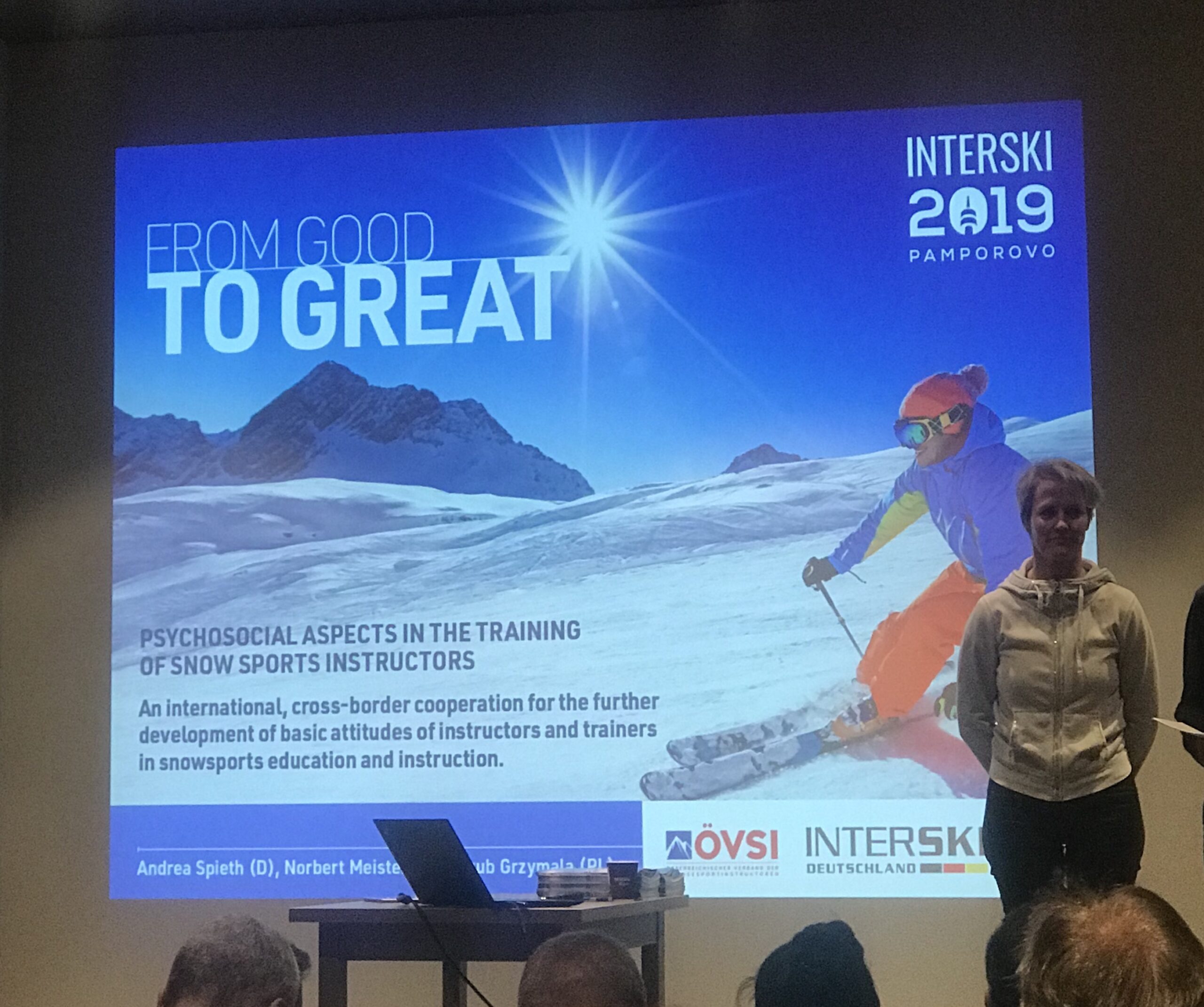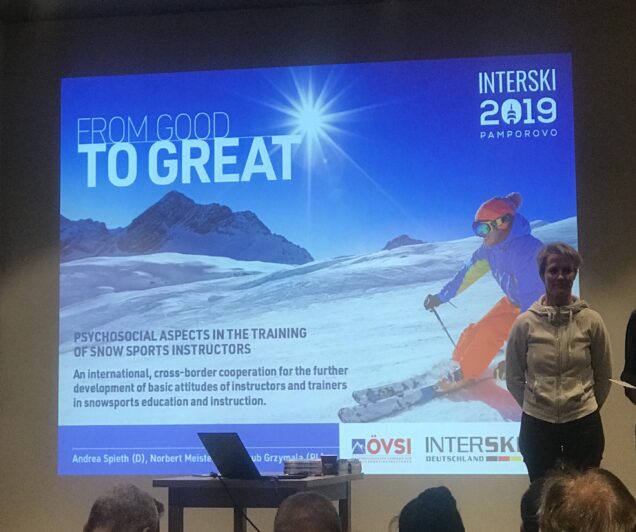The topic of this session revolved around the psychosocial aspects in the training of snow sports instructors, presented by German, Austrian and Polish presenters.

The thesis presented is that the goal is to go from being a good instructor to a great instructor. The key to becoming a great instructor is to support people to stay in their comfort zone and coach them so they can go beyond the limits of their comfort zone.
1: Neurobiological Aspects
Factors that influence us without us being aware of them…
What happens when our brain perceives a threat? The example given is to imagine you’re out for a run in the forest, and you encounter a bear in the trail. Increased heart rate, tense muscles, flight or fight mode. The amygdala takes control and prepares an emergency reaction: fight, flight or freeze…what the presenters referred to as “amygdala hijack”.
In teaching snow sports, it doesn’t take much of a threat to put someone in this state. In fact, our brain reacts similarly in social interactions as actual threatening interactions.
The SCARF model describes the way our brain interacts in social situations:
S: Status – relative importance, pecking order and seniority.
C: Certainty – the need of our brain to predict the near future.
A: Autonomy – perception of having things u see control.
R: Relatedness – being “in” or “out” of a social group.
F: Fairness – perception of fairness between people.
So What?
When we teach students (or train instructors) we need to keep the above factors in mind to ensure our students don’t experience “amygdala hijack”.
Our brain constructs our reality. Help your students to construct a positive reality and be in a state of well-being as often as possible.
2. Group Dynamics
Improving the learning experience by observing group dynamic processes.
The three models below show us how group behaviour can be observed:
- The Iceberg Model
- The Group Dynamic Space model
- Rank Dynamic model
Think of an iceberg – approximately 1/10th is visible above the water’s surface, and the rest is submerged and invisible. This is also the case in relationships and group dynamics – most of the important stuff is not visible or happening behind the scenes!
A sense of belonging is a vital part of a good group dynamic. Here are some examples of ways to create a sense of security and belonging:
- Getting to know each other by name.
- Finding out who knows who, and how well – this give social orientation.
- Actively encouraging contact between different group members during the initial phase.
- Sharing ideas on how to spend the time together.
- Putting the group and “WE” first.
The 3 aspects at play here are:
- Belonging: People who feel they don’t belong perceive this as a threat. The mind experiences social exclusion as physical pain.
- Power: Opportunities for participation and involvement increase motivation. Power demonstrations of the instructor help him/her more than they help the students.
- Nearness: Balanced attention by the instructor promotes a good learning climate in the group.
3. Coaching Role
How can we as instructors develop people’s full potential?
Coaching: Giving assistance in reaching desired results by reinforcing existing talents, asking the right questions, and expressing concern.
Using the SCARF principles, a good coach will minimize threats and maximize rewards.
Using Coaching to its Fullest
1. Serve your clients, and make them smile by doing a great job.
- Show your dedication to your job.
- They must feel that you care for their needs.
- Have empathy.
2. Form A Contract
- Define the rules of working together to ensure total confidence.
- The contract forms understanding of boundaries of the student and the coach.
- In a group situation, the contract should be understood by everyone (generally).
3. Set The Aims and Objectives by Defining the Goals and Setting Intentions
- Helps to realize what we’re here for.
- Open up, talk to clients, listen to their stories and tell yours.
4. Be an invisible leader – pacing and leading
- Let the client be at the front. Give them time and space to express opinions and theories. Follow the discussions and guide them gently to achieve results.
5. Promote Teamwork
- Resonance: Where do we connect?
- Synergy: Where are we different? Can they compliment one another?
- Emergence: What new can come of our interaction?
6. Feedback vs. Feedforward
- People love appraisal and hate judgement. Concentrate on solutions instead of problems.
- It is easier to show people things they can do better than to prove them wrong.
- “Feedforward” tips”
- Give students awareness exercises exploring critical parts of the movements.
- Explore the functions of the movements by going into extremes.
- Let them decide if it’s useful or not for their snowboarding. If not, research it further.
- Let the student describe their own experience / movements in their own words. This improves awareness by finding the words for a body experience, the coach gets a picture of the student, and can build the next steps.
7. Avoid Your Own Agenda
- Avoid the “too much’s”:
- Wanting to be liked.
- Wanting friends (desperately).
- Proving your skills
- Wanting results (not conforming to the client’s wishes)
- Needing income (desperately).
- Wanting to heal yourself.
8. A Bit of Anxiety Is Good!
A small dose is natural and beneficial. It means you care about how you do your job. But, too much is harmful! It’s crucial to recognize the emotional state of your students, so you can manage the amount of anxiety.
